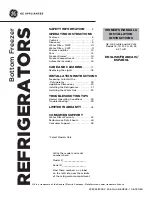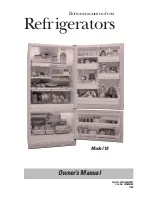
Service Procedure
38
©2007 Viking Preferred Service
Evacuation and Charging
CAUTION
To avoid risk of fire, sealed refrigeration system must be
air free. To avoid risk of air contamination, follow
evacuation procedures exactly.
NOTE:
Before opening any refrigeration system, EPA
regulations require refrigerant in system to be
captured for safe disposal.
Proper evacuation of sealed refrigeration system is an
important service procedure. Usable life and operational
efficiency greatly depends upon how completely air,
moisture and other non-condensables are evacuated
from sealed system.
Air in sealed system causes high condensing
temperature and pressure, resulting in increased power
requirements and reduced performance.
Moisture in sealed system chemically reacts with
refrigerant and oil to form corrosive hydrofluoric and
hydrochloric acids. These acids attack motor windings
and parts, causing premature breakdown.
Before opening system, evaporator coil must be at
ambient temperature to minimize moisture infiltration into
system.
Evacuation
To evacuate sealed refrigeration system:
1. Connect vacuum pump, vacuum tight manifold set
with high vacuum hoses, thermocouple vacuum
gauge and charging cylinder as shown in illustration.
Evacuation should be done through I.D. opening of
tubes not through line piercing valve.
2. Connect low side line to compressor process tube.
3. Connect high side line to drier/process tube.
4. Evacuate both simultaneously. With valve “C” and
“F” closed, open all other valves and start vacuum
pump.
Charging
Cylinder
Charging Hose
Charging Hose
Drier/Process Tube
F
Valve
A
B
C
D
Valve
E
Valve
Low Side Gauge
Thermistor
Vacuum Gauge
Vacuum Pump
0.6 cm Copper
Tubing
Compressor
Compressor
Process Tube
High Side Gauge
Equipment Setup for Evacuation and Charging
5. After compound gauge (low side) drops to
approximately 29 inches gauge, open valve “C” to
vacuum thermocouple gauge and take micron
reading.
NOTE:
A high vacuum pump can only produce a good
vacuum if oil in pump is not contaminated.
6. Continue evacuating system until vacuum gauge
registers 600 microns.
7. At 600 microns, close valve “A” to vacuum pump
and allow micron reading in system to balance.
Micron level will rise.
•
If in 2 minutes, micron level stabilizes at 1000
microns or below, system is ready to be charged.
•
If micron level rises above 1000 microns and
stabilizes, open valve “A” and continue evacuating.
•
If micron reading rises rapidly and does not stabilize,
a leak still exists in system, go to step 8.
8. Close valve “A” to vacuum pump and valve “C” to
vacuum gauge. Invert charging cylinder and open
charging cylinder valve “F” to add partial charge for
leak checking. With leak detector, check manifold
connections and system for leaks. After locating
leak, capture refrigerant, repair leak, and begin at
step 1.
















































